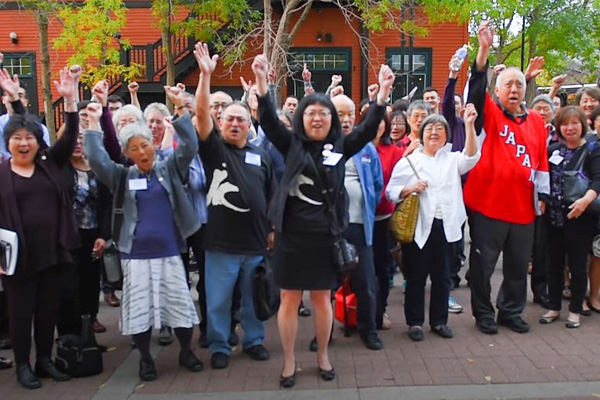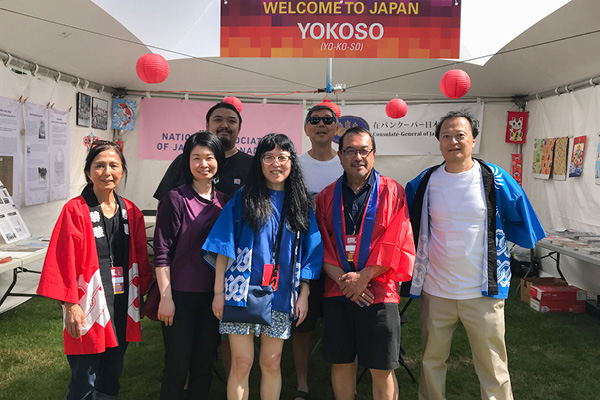 Bathed in the afterglow of the Redress Settlement, the Toronto Chapter executive held a meeting to discuss future directions and programs. The Sansei on the executive suggested that we needed to be more supportive of First Nations land claims. A Nisei member questioned, “What does it have to do with us?” We were taken aback by the question. The comment was a clear line between those who saw Redress from a larger human rights perspective and having the desire to harness the political and moral capital gained at the moment by pushing the human rights agenda for other ethno-cultural groups verses those who simply viewed the Redress Settlement as a Japanese Canadian issue. Nikkei must realize that the acceptance of the government apology and settlement contained the tacit obligation to be advocates for human rights. As I noted previously, our campaign did not gain momentum until we made the Redress campaign an issue of Canadian civil rights, thereby expanding ownership.
Bathed in the afterglow of the Redress Settlement, the Toronto Chapter executive held a meeting to discuss future directions and programs. The Sansei on the executive suggested that we needed to be more supportive of First Nations land claims. A Nisei member questioned, “What does it have to do with us?” We were taken aback by the question. The comment was a clear line between those who saw Redress from a larger human rights perspective and having the desire to harness the political and moral capital gained at the moment by pushing the human rights agenda for other ethno-cultural groups verses those who simply viewed the Redress Settlement as a Japanese Canadian issue. Nikkei must realize that the acceptance of the government apology and settlement contained the tacit obligation to be advocates for human rights. As I noted previously, our campaign did not gain momentum until we made the Redress campaign an issue of Canadian civil rights, thereby expanding ownership.
As noted by the Liberal Interim Leader Bob Rae, the plight of the aboriginal peoples of Canada affects Canadians and therefore all Canadians must assume responsibility for it. Our community is indebted to the Assembly of First Nations when, under the leadership of George Erasmus, we received much needed support for our campaign. The NAJC supports the AFN demand for a nation to nation dialogue with the Government of Canada and urges the Government to honour all treaty rights. On January 4th, the NAJC executive board sent a formal letter to Prime Minister Stephen Harper, requesting that he meet with National Chief Shaun Atleo and Attawapiskat Chief Theresa Spence. Contained in the letter was the NAJC support of the Assembly of First Nations; Chief Theresa Spence’s requests and the repeal of Bill C-45, which takes away existing treaty rights.
Two years ago when the earthquake and tsunami devastated the Tohoku region of Japan, our Nikkei community was galvanized into action and raised millions of dollars and continue to do so today. Sadly, as a community, we have been silent on the challenges faced daily by Aboriginal people. Is the plight of our First Nations people less urgent? The NAJC, under the leadership of Bev Ohashi ( Secretary and Community Development Chair) will begin educational initiatives with the Kehewin Cree Nation of Alberta. Linda Gadwa, Principal of Kehewin Community Education Centre, was the luncheon keynote speaker at last year’s annual general meeting held in Kamloops and was accompanied by her husband Chief Eric Gadwa. She gave the delegates and community members an overview of the challenges faced by her school and of the positive accomplishments of her students in spite of the inequality in Federal educational funding to reserves as compared to the provincial funding for public schools.
The internal conflict within the AFN is a natural process and to be expected. We faced this within our community and the government of the day unsuccessfully tried to exploit the rift. It is in the best interest of the Harper Government to negotiate in good faith with National Chief Shaun Atleo and produce concrete, measureable agreements or I am afraid that we will simply see an escalation – across Canada – of civil action by the aboriginal peoples and supporters. Chief Theresa Spence and the “Idle No More” movement created important leverage and generated media and public interest. Robert Fife, CTV News Ottawa Bureau Chief noted: “We’ve all covered native stories and they very rarely get any kind of coverage unless they’re of a situation where . . . people have died or they’re living in terrible conditions . . . Despite (Chief Spence’s) erratic behaviour and some of her demands, she definitely raised the bar in terms of focus on issues affecting First Nations peoples”(Toronto Star, January 26, 2013)
The “Idle No More” movement has also exposed the naked racism which continues to exist in this country as evidenced on the internet and local press. It is an opportunity for us to engage in frank dialogue about how to deal with such hatred and for our Nikkei community to explore the racism which exists within.
Without immediate progress we may be seeing the makings of not one but many Okas of 1990 when an officer of the Surete du Quebec (Quebec Provincial Police) was killed and a 14 year old Native girl, carrying a back pack, was bayoneted by a member of the Canadian military as she tried to protect her four-year-old sister. Ironically the victim, Waneek Horn-Miller, went on to represent Canada as a member of the Canadian women’s water polo team in the Sydney Olympics in 2000. Speaking to native youth, Horn-Miller said it’s time for this generation to move forward.
“We have got to thrive…in my life time, I want to see a Native prime minister. Our people are tough. We don’t quit after one failure. We don’t back down. We’ve proven that again and again.”(Wataway News, March 23, 2006, Vol. 33, #6)
It is time for Japanese Canadians to demand that this government honour treaty rights and help to nurture the aspirations of the First Nations peoples of Canada.



